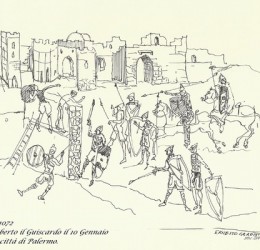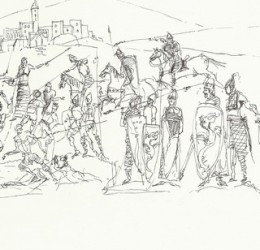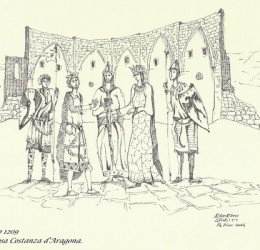NORMANNESIMO
Normannesimo is a pictorial work that was born from the suggestions of various aspects of Norman art in Sicily (architecture, sculpture, mosaics) and from all those contaminations that cross local culture (referring to Arabian, southern Italian and Byzantine workers). In Normannesimo significant scenes are transferred into pictorial images that represent the history of the Norman conquest of Sicily beginning with the battle of Cerami (1063) under Ruggero I from Altavilla, until the death of Federico II of Svevia. Ruggero I and his brother Roberto il Guiscardo began the process of reconquering Sicily from the Muslim dominion that lasted about 30 years. After the death of Ruggero I (the year 1101) his wife Adelasia del Vasto transferred her Court from Mileto (Calabria) to Sicily and there reigned until the year 1112 when her son Ruggero II took power. His reign was confirmed at his coronation on Christmas Day in the year 1130 in Palermo. Ruggero II died February 26th, 1154 at the age of 58. The crown officially passed on to his son, Guglielmo I, who had actually already been ruling for three years. Upon his death, his son, Guglielmo II, was solemnly incoronated by the Bishop Romualdo in a Catholic cathedral. Meanwhile, Federico I Barbarossa’s new diplomatic strategy was getting under way concerning Sicily and in 1183 he proposed a union by way of marriage between Costanza of Altavilla, daughter of Ruggero II, and his son Enrico VI of Hohenstaufen. However at just 36 years of age, Guglielmo II died with no heirs to his throne. The reign passed into the hands of Tancredi di Lecce, who was crowned on the 18th of January, 1190 in the cathedral of the city of Palermo. At his death, the reign passed to the aforementioned Enrico VI di Svevia, following his wedding with the last of the descendants of Altavilla, Costanza, and the the 25th of December 1194 he received his crown as King of Sicily. Meanwhile, his wife Costanza, in heavy labor, stopped at Jesi, in March, where she gave birth to Federico II. The world honored Federico II as King of Sicily, lord of arms and literature and he was given the nickname of “Stupor mundi” (Latin for ‘world wonder’). He died in the year 1250 and was buried in the cathedral of Palermo. The entire series draws inspiration from the tapestry of Bayeux, a strip of fabric made of flax and wool, 50 cm high and 70.34 cm wide, which today is kept in the museum of Bayeux in Normandy. Woven into the fabric is a pictorial representation of the Norman conquest of England led by Guglielmo the Conquerer after the celebrated battle of Hastings in 1066. The series “Normannesimo” consists of 50 oil paintings using strictly the colors of bladder green, Mars red, ochre Yellow (dark and light) and dark cobalt blue. Raw jute is applied to the canvas in fragments picturesquely embroidered in wool utilizing various techniques. The background parts include black inscriptions of medieval Latin relating to the scene represented in the painting. The frames containing these works are each uniquely handmade of wood from lime trees containing decorative elements inspired by the Norman iconographic repertoire; the frame has a central section of black on which are placed, to settle the decoration, various pieces painted in the five colors mentioned above. The finished works, complete with frame, each share the same dimensions of 116 x 86 cm.
The whole cycle takes it’s inspiration from “Arazzo Di Bayeux”, a strip of linen fabric and wool, about 50 cm high and 70.34 cm long; is now housed in the museum of Bayeux – Normandy. In the tapestry is represented the Norman conquest of England by William the Conqueror, after the famous battle of Hastings of 1066. The works are in total 50, the technique used is oil, the colors used are green, the bladder, the red of Mars, the dark yellow ocher and clear, and dark cobalt blue. Are applied to the canvas inserts raw jute (called “fragments”), embroidered in wool with the picturesque and the grass, with the colors the same as those of tapestry of Bayeux. Parts including the black, appearing in medieval Latin inscriptions (relating to the scene represented), with the same period of the Latin character Ruggeri, recognizable in the inscription found to the Palace of the Normans in Palermo on the opening clock water sought by king Roger II in 1141. The frames that enclose the works are in linden wood. Each frame is hand built on a single project, from decorative elements of the apses, portals of churches and cloisters Norman columns, the frame has a black center section on which the accommodation is to compose the decoration, the various pieces painted with the colors above cited. The works include finite frames have dimensions of cm 116xcm86.The artwork is on permanent display atMuseo Regionale di Palazzo d’Aumale.
Altavilla: Italianisation of the original hauteville-le-guichard that indicates the origin of a family of small landowners Normans who settled in southern Italy unifying and making a significant contribution to removal of the Byzantines and Muslims. He was founder Tancredi who had twelve sons. The first Norman to win fame and position in southern Italy was Ranulf I Drengot. The Duke of Naples, Sergius IV, gave him in marriage his sister, already widow of the Duke of Gaeta, and invested him with the county of Aversa. Aversa is the only city ‘founded by the Normans in the South. After the death of his wife, Rainulfo changed deployment, marrying a niece of an enemy of the Duke of Naples, Prince of Capua Pandolfo IV and becoming vassal. Soon he support ed the Prince of Salerno Guaimario IV also getting the Duchy of Gaeta (1041). In this period came in the South, the brothers William tug of war, and Drogo, the sons of Tancred. William tug of war in 1042 became Count of Apulia getting the territories from which he had crushed the Byzantines against which they had arisen cities’ of Puglia. From here there began the expansion of Altavilla. In fact, Drogo of Hauteville, the successor of William tug of war, received the investiture of the county of Apulia, while Ranulf “the Trincanocte” that the county Aversa. Even the Pope wanted to tell her about the fate of the south, when the population of Puglia called him for help against the attackers. Leo IX (1049-1054) tried to remove the Normans from southern Italy with the help of German troops and Byzantine. In Ciivitate however, in the north of Apulia , suffered a complete defeat. So, consequently the papal policy towards the Normans changed. In fact, Niccolò II (1058.1078) formed an alliance with the invaders, and during the Synod of Melfi (1059), invested the count of Aversa, Richard I Quarrel (1050-1078), with the principality of Capua. At the same time proceeded to invest Robert Guiscard (the smart) as count of Apulia taken over as heir of his brother Humphrey, and the Duchy of Calabria and in the future, with the help of God and St. Peter, of Sicily. Until then, the Normans had distinguished themselves for the brutality of their violence, which had not spared the goods of the Church. Once they became vassals of the Pope, they turned into benefactors making donations to churches and monasteries, where they now prayed for the salvation of their souls. They also established new monasteries where monks introduced the Normans. Many Normans came from Britain as well as from Normandy, places where there was no more space for many young nobles that they had to seek fortune elsewhere. Thanks to their weapons on horseback with a slight crush on knit and a shield long, almond-shaped, they were in a condition of superiority than their opponents Byzantines and Muslims. They took possession of new fighting techniques, such as, the construction of towers wooden furniture that made more easy to approach the walls of the city. The disunity of local forces opened the road to the invaders. An important tool for integration was the marriage with girls of the local aristocracy. Returning to Altavilla, in 1055 in southern Italy Guiscard’s brother, Roger I, arrived. After an aid to quell a rebellion, and a series of conflicts with the same brother Robert to have an independent domain in Calabria together strengthened their domain and began the reconquest of the island “Sicily” then brought to an end by Roger I, who held the title of Count. The duchy of Apulia and Calabria and the County of Sicily were reunited, after some of the events inside the descending branch from Guiscard, under Roger II of 1130 assumed the title of King of Sicily. Did not survive him none of the first three children. He was succeeded by the fourth, William I “the Bad” which in turn leaft the title to his son William II “the Good”. He died without heirs closing the dynasty of Altavilla and triggering the attempt to rise to the throne of Tancred of Lecce, illegitimate grandson of Roger II. The armed intervention of Henry VI, according to the rights arising from his marriage to Constance of Altavilla, put and to the Norman rule of Sicily.








































































































 English
English Italiano
Italiano